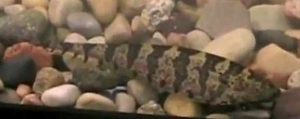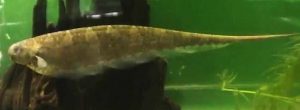The Centipede Knife Fish (Steatogenys duidae) also known to tropical fish keeping enthusiasts as the Leaf Knifefish or Grass Knifefish, is a nocturnal South American species that is found primarily in the deep water forest pools and creeks of the Amazon River and it’s tributaries throughout Venezuela and Brazil.
During the rainy season, Centipede Knife Fish are often found lying on the bottom of deeper leaf littered pools in small schools where they have easy access to worms, insect larvae, and small crustaceans that they feed on. They prefer leaf littered substrates and pools with stronger currents where they blend in to avoid predation from larger species.
Centipede Knife Fish have a round head and a long flat body that becomes more rounded as it tapers toward the tail into a fine point. They have no apparent dorsal fin, and an anal fin that runs underneath the entire length of the fish.
They are colored a brown to light tan, in a zig zag banded pattern that blends into the leafy substrate that they are often found among.
Like many knife fish species, Centipede Knife Fish have poor eyesight but posses an electric organ that they use to generate a weak electrical field around them, which allows them to communicate with others of their own kind, find a mate, navigate their surroundings, and locate the crustaceans, worms, and larvae that they feed on.
Although Centipede Knife Fish are a shy, peaceful species that usually do not bother other fish; in an aquarium environment, they need to be kept with at least 6 or more of their own kind to minimize individual bullying. Kept singly in a community aquarium, they tend to be shy and will hide during the daylight hours, and when kept in smaller groups, they tend to constantly pick on each other to establish a “pecking order” of sorts.
Steatogenys duidae are relatively easy to care for compared to other knife fish species.
They do best in a densely planted aquarium of at least 55 gallon capacity, with a sand or very fine gravel substrate, some driftwood and rocks formed into caves for them to hide among, and some floating plants
to diffuse overhead lighting. They require good water quality, a moderate amount of water movement, and regular 30 – 50% weekly water changes to keep them healthy. A high quality canister type filtration system is recommended for this species.
Many tropical fish keeping enthusiasts place a clear acrylic or plastic tube into their tank as a hiding place so they can be observed during daylight hours, while others install “moonlight” blue LED lights on their tank to view them at night.
When kept in a community tank setting, they have been known to eat smaller fish like guppies, neons, etc., however, they should not be housed with much larger, overly aggressive, or fast moving species. Because of their shy demeanor, too much activity in the tank tends to make them hide during the day.
Keeping them in groups of 6 or more fish, or with other calm, non aggressive species will alleviate the problem.
Centipede Knife Fish have never been bred in an aquarium environment and little is known about their reproduction activities.
Feeding Centipede Knife Fish is often the biggest challenge encountered with this species, especially when they are housed in a community environment.
As they get used to their surroundings, feeding them becomes a bit easier but because of their timidness, they usually hide when their tank mates are in a frenzy as they are being fed. This being said, in the wild Centipede Knifefish are carnivores that eat when the sun sets.
They will accept fresh or frozen bloodworms, black worms, chopped earthworms, brine shrimp, baby guppies, pond snails, and ghost shrimp. Although they have been “trained” to eat freeze dried bloodworms
, they will usually never accept commercial flake foods or pellets. Feed them when the lights are turned off on the tank and the food is on the bottom.
Centipede Knife Fish (Steatogenys duidae) are not common in tropical fish keeping shops however, they have recently become more available online and from specialty fish shops at moderate prices.
Minimum Tank Size: 55 gallons
Care Level: Moderate
Temperament: Peaceful
Aquarium Hardiness: Hardy as adults
Water Conditions: 74.0 to 82.0° F, 5 – 10 dGH, pH 6.0-6.5
Max. Size: 8.25″
Color: Brown, Tan
Tank Compatability: groups of 6 or more
Diet: Carnivore
Origin: Venezuela, Brazil
Family: Hypopomidae
Lifespan: 15 years
Aquarist Experience Level: Advanced




